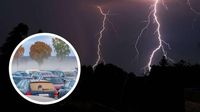Germany is preparing for a rare meteorological phenomenon this weekend, known as "Blutregen" or blood rain, which is expected on Saturday, March 22 and Sunday, March 23, 2025. This peculiar event occurs when rain combines with Saharan dust carried across the atmosphere, resulting in reddish or yellowish-colored precipitation that often stains cars and outdoor surfaces.
According to the German Weather Service (DWD), the blood rain will predominantly affect southwestern regions of Baden-Württemberg, though it could also be observed in parts of Bavaria and the Rhineland-Palatinate. With thunderstorms likely on Saturday, this weather pattern could cause the phenomenon to produce significant amounts of rainfall.
The distinctive atmospheric conditions leading to this unusual precipitation began to develop over the last week, as strong winds from the Sahara stirred up considerable dust and transported it to Germany. Reports indicate that a concentrated cloud of Saharan dust was already visible in the sky over southwestern Germany on March 21, 2025, creating unusual colors and haziness.
As one meteorologist noted, "Local strong thunderstorms for March" can be anticipated, which may lead to heavy rainfall amounting to around 20 liters per square meter in short periods. This could make the blood rain particularly intense in certain localized areas, especially near the Alps and in the south.
In anticipation of the blood rain, car owners have been urged to exercise caution. The Auto Club Europa has advised that thorough pre-washing with plenty of water is necessary to avoid potential damage to car paint from the Saharan dust that will settle on vehicles after the rain.
The potential for blood rain comes alongside a significant drop in temperatures over the weekend. After experiencing warm weather, with highs around 22 degrees Celsius on Friday, temperatures will plummet to a relatively cool range between 10 to 16 degrees Celsius by Sunday across various regions. After this weekend, a more stable weather pattern is expected to return, making the Saharan dust and associated rainfall a fleeting natural occurrence.
Despite the seemingly ominous nature of blood rain, health experts suggest that there is minimal danger associated with Saharan dust under normal circumstances. Saharan dust particles are larger than many pollutants, thus they pose a lower health risk compared to finer particulate matter found in urban settings. However, sensitivity to dust can vary among individuals, especially for those with respiratory issues.
Following the blood rain, meteorologists predict that the Saharan dust will either be washed away or dispersed through winds, leaving a relatively clear atmosphere by Monday, March 24, 2025. The DWD will continue to monitor this phenomenon, providing updates as conditions change.
With this blood rain event occurring, it's essential for residents and travelers in the affected regions to stay informed about weather updates from the DWD to better prepare for local conditions. As the phenomenon captures the public's interest, images of blood rain-stained landscapes are sure to make rounds across social media, drawing increased awareness to this unique meteorological occurrence.
As brutal weather patterns increasingly define seasonal changes, the appearance of blood rain serves as a stark reminder of the vibrant but sometimes unpredictable nature of our environment.









